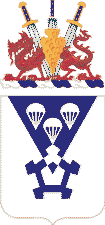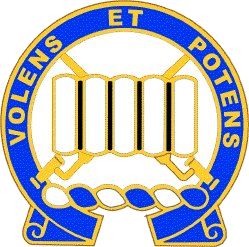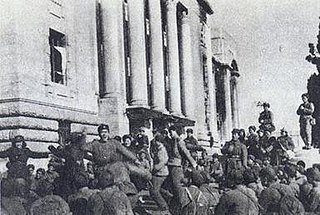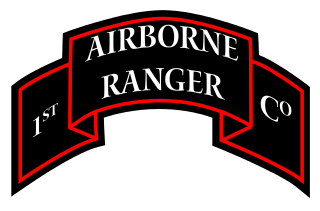
The 2nd Infantry Division is a formation of the United States Army. Its current primary mission is the pre-emptive defense of South Korea in the event of an invasion from North Korea. There are approximately 17,000 soldiers in the 2nd Infantry Division, with 10,000 of them stationed in South Korea, accounting for about 35% of the United States Forces Korea personnel.

I Corps is a corps of the United States Army headquartered in Joint Base Lewis-McChord, Washington. It is a major formation of United States Army Pacific (USARPAC) and its current mission involves administrative oversight of Army units in the Asia-Pacific region, including the Pacific Pathways program.
This is the Korean War order of battle. Subsidiary commands are listed on sub-pages. Where no date is shown for a command, assume it present at the start of the war, on June 25, 1950.

The 24th Infantry Division was an infantry division of the United States Army. It was inactivated in October 1996, it was based at Fort Stewart, Georgia and later reactivated at Fort Riley, Kansas. Formed during World War II from the disbanding Hawaiian Division, the division saw action throughout the Pacific theater, first fighting in New Guinea before landing on the Philippine islands of Leyte and Luzon, driving Japanese forces from them. Following the end of the war, the division participated in occupation duties in Japan, and was the first division to respond at the outbreak of the Korean War. For the first 18 months of the war, the division was heavily engaged on the front lines with North Korean and Chinese forces, suffering over 10,000 casualties. It was withdrawn from the front lines to the reserve force for the remainder of the war after the second battle for Wonju, but returned to Korea for patrol duty at the end of major combat operations.

IX Corps was a corps of the United States Army. For most of its operational history, IX Corps was headquartered in or around Japan and subordinate to US Army commands in the Far East.

The Republic of Korea Marine Corps, also known as the ROK Marine Corps (ROKMC), or the ROK Marines, is the marine corps of South Korea. The ROKMC is a branch of the Republic of Korea Navy responsible for amphibious operations, and also functions as a rapid reaction force and a strategic reserve.

The 1st Ranger Battalion, currently based at Hunter Army Airfield in Savannah, Georgia, United States, is the first of three ranger battalions belonging to the United States Army's 75th Ranger Regiment.

The 503rd Infantry Regiment, formerly the 503rd Parachute Infantry Regiment and the 503rd Airborne Infantry Regiment, is an airborne infantry regiment of the United States Army. The regiment served as an independent regiment in the Pacific War during World War II; at Fort Campbell, Kentucky; in Okinawa, Japan; and in Germany. Regimental elements have been assigned to the 2nd Infantry Division, the 11th Airborne Division, the 24th Infantry Division, 25th Infantry Division, the 82nd Airborne Division, 101st Airborne Division, and the 173rd Airborne Brigade Combat Team. Regimental elements have participated in campaigns in the Vietnam War, Operation Enduring Freedom–Afghanistan, and Operation Iraqi Freedom. The regiment claims 15 Medal of Honor recipients: two from World War II, ten from Vietnam, and three from Afghanistan. A parent regiment under the U.S. Army Regimental System. The regiment's 1st and 2nd Battalions are active, assigned to the 173rd Airborne Brigade, based at Caserma Ederle, Vicenza, Italy. The 3rd and 4th Battalions as well as Companies E, F, G, H, and I have been inactived.

The 24th Infantry Regiment was a unit of the United States Army, active from 1869 until 1951, and again from 1995 until 2006. Before its original dissolution in 1951, it was primarily made up of African-American soldiers.
The Korean War Ranger Companies were the United States Army Rangers of the Korean War.

The 7th Infantry Regiment is an infantry regiment in the United States Army. In its 200-year history it has participated in 12 wars, been awarded 78 campaign streamers, and 14 unit decorations. The regiment has served in more campaigns than any other infantry unit in the United States Army.
The 32nd Infantry Regiment is a battalion within the United States Army. Of the original regiment, only the 1st Battalion remains as an active duty unit. The 1st Battalion, 32nd Infantry Regiment is a light infantry battalion assigned to the 1st Brigade Combat Team, 10th Mountain Division, garrisoned at Fort Drum, New York. The battalion was previously assigned to the 3rd Brigade Combat Team at Fort Drum, before this unit was reflagged to Fort Polk, Louisiana.

The Battle of the Ch'ongch'on River, also known as the Battle of the Ch'ongch'on, was a decisive battle in the Korean War, and it took place from November 25 to December 2, 1950, along the Ch'ongch'on River Valley in the northwestern part of North Korea. In response to the successful Chinese First Phase Campaign against the United Nations (UN) forces, General Douglas MacArthur launched the Home-by-Christmas Offensive to expel the Chinese forces from Korea and to end the war. Anticipating this reaction, the Chinese People's Volunteer Army (PVA) Commander Peng Dehuai planned a counteroffensive, dubbed the "Second Phase Campaign", against the advancing UN forces.

The Third Battle of Seoul, also known as the Chinese New Year's Offensive, the January–Fourth Retreat or the Third Phase Campaign Western Sector, was a battle of the Korean War, which took place from December 31, 1950, to January 7, 1951, around the South Korean capital of Seoul. In the aftermath of the major Chinese People's Volunteer Army (PVA) victory at the Battle of the Ch'ongch'on River, the United Nations Command (UN) started to contemplate the possibility of evacuation from the Korean Peninsula. Chinese Communist Party chairman Mao Zedong ordered the Chinese People's Volunteer Army to cross the 38th Parallel in an effort to pressure the UN forces to withdraw from South Korea.

The First and Second Battles of Wonju, also known as the Wonju Campaign or the Third Phase Campaign Eastern Sector, was a series of engagements between North Korean and United Nations (UN) forces during the Korean War. The battle took place from December 31, 1950 to January 20, 1951 around the South Korean town of Wonju. In coordination with the Chinese capture of Seoul on the western front, the North Korean Korean People's Army (KPA) attempted to capture Wonju in an effort to destabilize the UN defenses along the central and the eastern fronts.

The Eighth Army Ranger Company, also known as the 8213th Army Unit, was a Ranger light infantry company of the United States Army that was active during the Korean War. As a small special forces unit, it specialized in irregular warfare. Intended to combat the North Korean (NK) commandos who had been effective at infiltration and disruption behind United Nations (UN) lines, the Eighth Army Ranger Company was formed at the height of the Battle of Pusan Perimeter in September 1950 and was the first U.S. Army Ranger unit created since World War II. The company went into action as a part of the 25th Infantry Division during the UN advance into North Korea in October and November. It was best known for its defense of Hill 205 against an overwhelming Chinese attack during the Battle of the Ch'ongch'on River which resulted 41 of the 51 Rangers becoming casualties.

The 1st Ranger Infantry Company (Airborne) was a Ranger light infantry company of the United States Army active during the Korean War. As a small special forces unit, it specialized in irregular warfare.

The 2nd Ranger Infantry Company (Airborne) was a Ranger light infantry company of the United States Army active during the Korean War. As a small special operations unit, it specialized in irregular warfare. A segregated unit, all of its personnel, including its officers, were African-Americans.

The 3rd Ranger Infantry Company (Airborne) was a Ranger light infantry company of the United States Army active during the Korean War. As a small special forces unit, it specialized in irregular warfare.

The Battle of Pyongyang was one of the major battles of the United Nations' offensive during the Korean War. Following the Battle of Inchon, the UN forces re-captured Seoul, the capital of South Korea, and proceeded to advance into North Korea. Shortly after advancing, the American and South Korean forces faced the North Korean defenses near Pyongyang, the capital of North Korea, on 17 October.


















